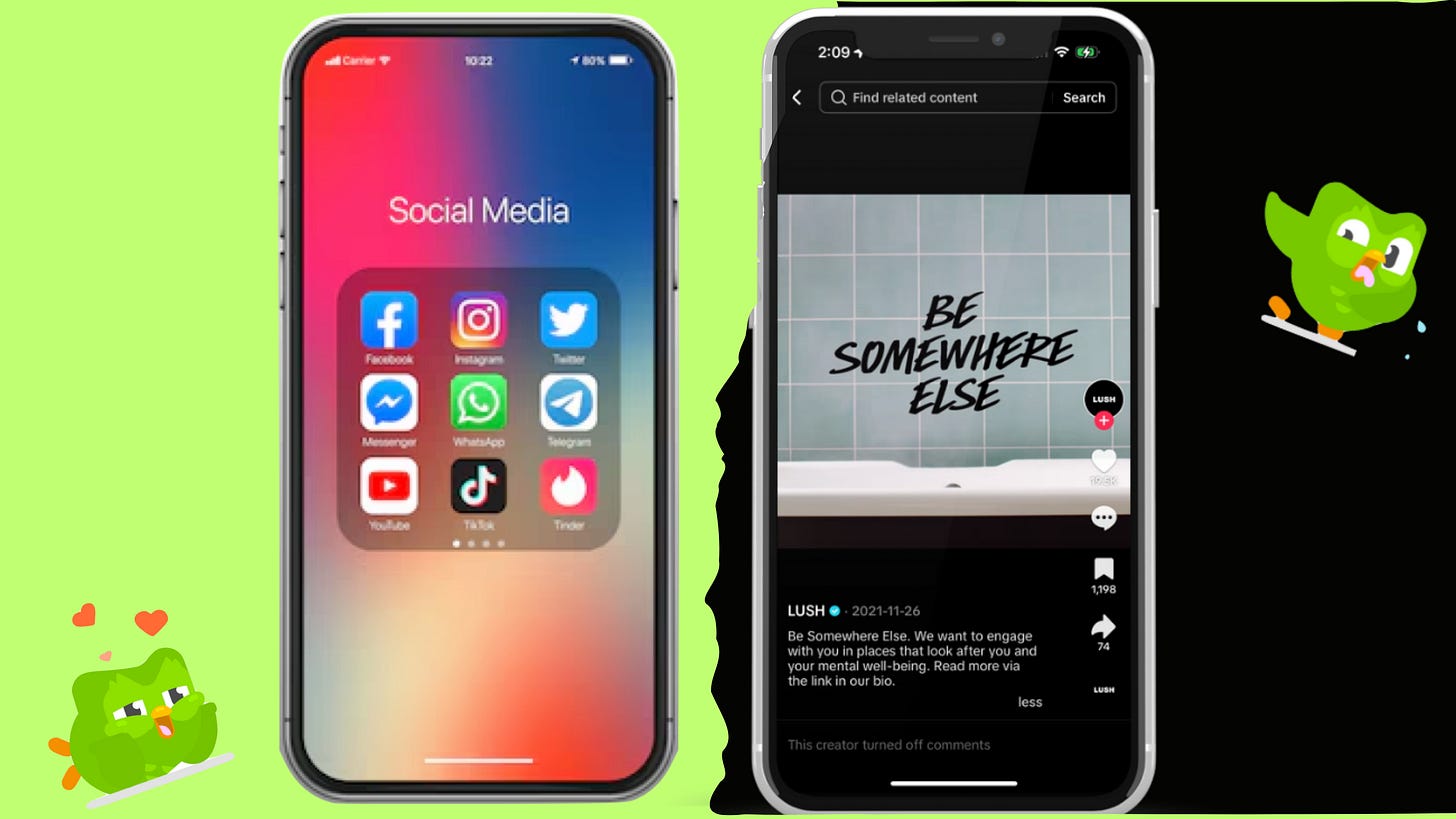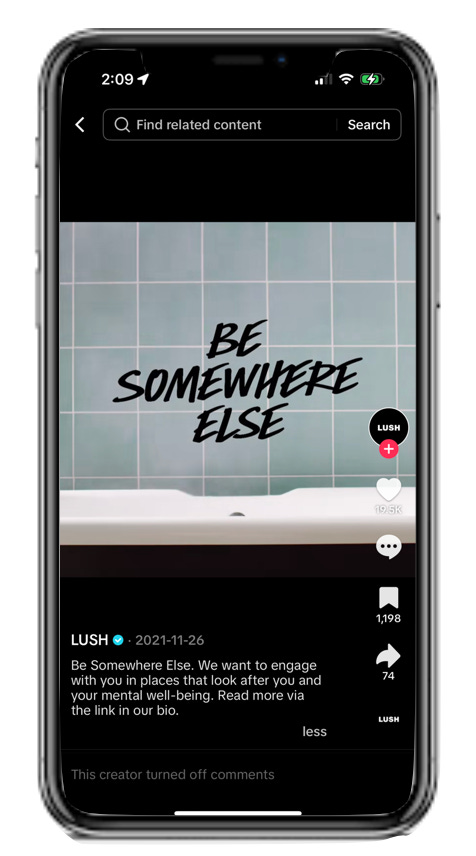From Swoosh to Start-up: Social Media’s Evolving Role in Brand Growth
What do Lush, Wendy's and Duolingo have in common? A bold social media playbook.
Issue #14
A Tale of Two Brand Worlds
Ever had that moment where you step into a completely new role and realize you’re playing by a different set of rules? That’s exactly how I felt leaving my marketing role at Nike - an established giant with decades of brand muscle - and heading over to Chipp, a bill splitting and expense management app for students and young professionals. Suddenly, my perspective on social media has morphed from a modest piece of a sprawling brand strategy into a colossal stage where awareness, trust, and growth all play out in real time.
This shift got me wondering: how does social media’s role in growing a brand vary by stage and industry? What can I carry over from a legacy powerhouse like Nike, famous for its iconic swoosh, into a brand-new world of fintech apps jockeying for user attention? And how are other brands—big and small—using (or avoiding) social channels to stay in the spotlight?
Let’s dive in.
Virality vs. Sustainability: Is Every Publicity Hit Worth It?
In the start-up world, especially if you’re targeting younger audiences, it’s easy to think one viral post can send you rocketing into the stratosphere. And sure, we’ve all seen overnight successes on TikTok: a single video can rack up millions of views in less time than it takes to brew coffee. The old saying, “any publicity is good publicity,” gets tossed around a lot. But does chasing that sensational moment actually pay off in the long run?
But do these short bursts of attention translate to sustained business growth? You might land 15 minutes of fame - maybe even a quick spike in app installs - but once the hype fizzles, you’re left scrambling for the next big splash. For a small brand with limited resources, gambling everything on a roller-coaster approach can be risky.
That doesn’t mean virality lacks value when it’s authentic and on-brand. Consider the 2024 Starbucks “Blossom Cloud Latte” frenzy, sparked by a lone TikTok user who noticed how pastel foam created vibrant swirls when stirred. Within 72 hours, #BlossomCloudLatte soared past 1.5 billion views, causing sellouts at multiple locations. By the end of Q2, Starbucks reported a 6% bump in same-store sales, largely credited to the online uproar. Here, a timely spark didn’t just generate clicks; it drew real crowds—and Starbucks was quick to credit the power of a playful social moment.
Yet for every “Blossom Cloud Latte” triumph, there are a dozen viral flops nobody remembers. Or, worse, stunts that backfire and push people away. A safer move is to develop consistent, genuinely helpful content that draws a loyal community. A viral surge can be icing on the cake, but trust and engagement are what truly sustain a brand.
“You need a social media strategy that works every day, not just when the algorithm blesses you.” - Neil Patel
Duolingo’s Wild Ride (and Why It Works)
If you’ve scrolled TikTok in the last couple of years, you’ve probably met Duolingo’s green owl, Duo - goofy, irreverent, and instantly recognizable. That offbeat personality has helped Duolingo amass nearly 17 million TikTok followers. But here’s the bigger win: monthly active users jumped from 40.5 million in 2021 to 116.7 million recently, with revenue climbing alongside.
Their secret? They’re genuinely fun. Their feed isn’t a hard sell, it’s an ongoing inside joke with fans. People love interacting with Duo’s random antics, and it nudges them to open the app for their daily practice. This is social at its best: forging real bonds that keep folks returning, not just to watch the next video, but to engage with the product.
For a newer brand, Duolingo’s success is a blueprint: be authentic, entertaining, and community-centric. Viral hits may come, but they’re byproducts of a steady, engaging brand presence rather than the be-all and end-all.
Lush Quits Social… and Survives?
On the flip side, consider Lush Cosmetics. In late 2021, they basically ghosted all major social platforms, abandoning 10+ million followers over ethical concerns like data privacy and mental health. At first, many industry folks were convinced it was brand suicide. How does a consumer-facing company, especially one with a younger audience, just unplug from the very platforms where its fans hang out?
But three years on, Lush is doing fine. They channeled energy into owned media (an app with 1.75 million users, a newsletter of 6 million subscribers) and in-store communities. Customers still post about Lush—just without an official brand account guiding them.
By walking away, Lush affirmed that you can thrive without being glued to someone else’s algorithm. It may be an extreme tactic, but it underscores a vital question for smaller, scrappier brands: can you build that same sense of loyalty through word-of-mouth, newsletters, and real-world connections if social media ever stops delivering results?
One Size Never Fits All: Industry-by-Industry Snapshots
Beauty & Cosmetics: Perfect for compelling visuals and influencer partnerships. e.l.f. soared with its #EyesLipsFace TikTok challenge, while Lush famously exited social. Either way, personal recommendations and user-generated tutorials reign.
Fashion & Apparel: Younger labels lean on ambassadors and hashtags (Gymshark, H&M), while luxury houses like Chanel keep a polished presence, cautiously trying TikTok to court Gen Z. Marketplaces like Whatnot add a peer-to-peer dimension and are creating their own social commerce platform.
Tech (B2C): Apple is famously aloof on social, while Duolingo is comedic and in-your-face. The common thread? Understand your audience. Apple banks on product hype; Duolingo banks on entertainment.
B2B / SaaS: Tends to stick to LinkedIn, Twitter, and conferences (think Salesforce’s Dreamforce), focusing more on thought leadership and community than viral memes.
Food & Beverage: Feuds and banter rule the day. Wendy’s roasts rivals, Popeyes incited the “chicken sandwich wars,” and Chipotle showcases TikTok menu hacks. Start-ups often rely on pop-up events and micro-influencer reviews to generate buzz.
Fintech: My new terrain. Users want a dash of fun but also take finance seriously. Short-form videos can make budgeting or investing sound approachable, but trust signals—like partnerships or educational articles—seal the deal.
Long-Form Writing: Substack’s New Frontier
While short-form social media often steals the spotlight, some brands are quietly embracing the return of long-form content—especially on Substack. As Rachel Karten noted, companies like Tory Burch, The RealReal, and Saie have begun exploring the platform’s newsletter format. Unlike typical email blasts, these brand-led Substacks function more like editorial mini-magazines, mixing style tips, insights, and behind-the-scenes stories.
It’s a more personal approach than chasing quick social hits. For instance, Tory Burch treats her Substack, “What Should I Wear?”, as a natural extension of her brand’s storytelling heritage, weaving in real voices and curated picks. Meanwhile, The RealReal’s “RealGirl” dispatches blend casual commentary with product links, creating an almost diary-like vibe.
While it’s still marketing, it feels less disposable than a social feed—readers opt in, and you can deliver deeper, more human stories. Whether this is a passing trend or a permanent shift, it underscores how brands are seeking genuine connections beyond the algorithmic churn.
Legacy Brands: Why They’re So Selective
At Nike, I saw firsthand how a legacy player doesn’t need to chase every new trend. Apple tweets sparingly, yet remains wildly popular with Gen Z. Nike posts mesmerizing visuals and inspirational stories, but rarely engages in comedic stunts. Both keep a tight grip on brand voice. Some might call it distant, but the numbers suggest otherwise—Gen Z are still flocking to iPhones and Air Force 1s.
The risk, of course, is seeming too corporate and out-of-touch. That’s why occasional user-generated content or influencer collabs can add authenticity without undermining a carefully honed image.
Finding Your Social Pulse (Regardless of Industry)
Social media isn’t irrelevant… far from it. The old playbook of blasting out links or hunting for cheap clicks is fading fast. The platforms themselves prioritize content that keeps users from leaving, so a brand’s best move is to meet audiences where they are. That might mean posting videos natively or adopting a more casual, human tone.
Social platforms reward content made specifically for on-platform engagement. The more you force “click-outs,” the more your reach may suffer.
Striking the Right Balance for Your Brand
Ultimately, there’s no single formula for how much energy you should invest in social channels. Early-stage brands might thrive on fast feedback and visibility, whereas established names can afford to pick their battles. Either way, authenticity and relevance matter most.
Duolingo embraces its quirky soul; Lush doubles down on ethics over social hype; Apple stays mysterious; Nike stays curated. The sweet spot lies between riding viral waves and staying true to your foundational values.
As I chart the next phase for our fintech brand, Chipp, I’m taking notes from all these angles. We’ve learned firsthand that short, playful TikToks on splitting a pizza bill can be unexpectedly powerful—yet we still need robust product demos and security assurances to establish trust. It’s less about chasing fleeting trends and more about connecting with people on a deeper level.
Because when you forge real, lasting bonds with your audience, you get more than a moment in the spotlight—you get a loyal community that grows with you, no matter what the algorithm decides.





